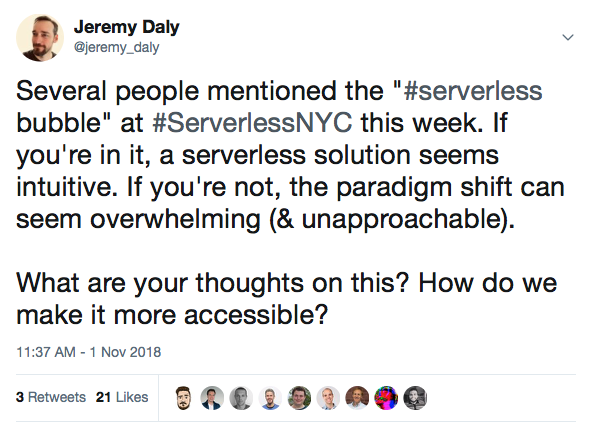Off-by-none: Issue #10
November 6, 2018
Do you hear what I hear? 👂
Welcome to Issue #10 of Off-by-none. Thanks for joining us! 👍
Last week we talked about how serverless was starting to gain quite a bit of momentum with things like the announcement of more tools and conferences. However, my attendance at the ServerlessNYC conference was a bit of an eye-opener for me. I spoke with a lot of people about a “serverless bubble” (although echo chamber is probably a better way to describe it). I knew that the serverless community was still relatively small, but have we gotten to the point where we’re just feeding the community and not doing enough to expand it?
This week we’re going to explore the topic of serverless adoption and offer up some resources to help companies and developers get started with this amazing technology. Let’s go! 🏎
When you realize you might be in a serverless echo chamber… 🙉
I posted this tweet a couple of days after the ServerlessNYC conference and I got quite a bit of feedback. There were several people pushing back on the idea, but I think many of those who did are in the “serverless echo chamber” themselves. There was a lot of discussion here that needs to be boiled down and researched a bit more, but I think it is clear that there are a number of factors that are hampering serverless adoption. I’d love to know your thoughts on this, so please weigh-in on the Twitter thread, or send me a note.
When you’re sad that you missed ServerlessNYC… 🗽
It really was a great event. But cheer up, my friend, there’s no need for #FOMO. I’ve put together a recap of the event with all the key takeaways and lessons learned.
TLDR; Kelsey Hightower made you rethink the barriers to serverless adoption, Jason Katzer told us that unlimited still has limits, Gwen Shapira gave us new ways to think about serverless data flow, Ben Kehoe made us adopt a new serverless native mindset, Tyler Love showed us that serverless can easily handle billions of requests, Chase Douglas filled some gaps for us in the serverless development lifecycle, and an open source serverless panel told us we need to work on standardization.
When you realize that serverless is more than functions… 🎉
Epsagon recently launched their distributed tracing product for serverless applications, and decided to kick it off with a star-studded webinar (plus me 🤣). But seriously, Shannon, Nitzan and Ran are doing some great things around serverless observability. This discussion, with insights from Yan Cui and Corey Quinn, was really interesting. You can watch, listen, or read it here.
Speaking of webinars, Forrest Brazeal is hosting an AWS Online Tech Talk called Serverless Workflows for the Enterpise on November 14, 2018 at 12pm ET. This will focus on how to seamlessly build and deploy serverless applications across multiple teams in large organizations. Should be a great intro for enterprises looking to adopt serverless.
When you’re still on the fence about adopting serverless… 🎓
7 tools that ease serverless adoption outlines a few of the tools we’ve been talking about for a while. While this isn’t an exhaustive list, the article does give recommendations for the three major areas of serverless applications: development, monitoring and security. There are a lot of other tools out there (like the Serverless Framework) that can help you jump into the serverless waters, but this is a good list to get you started. ⚡️
Ben Kehoe was interviewed by the Wall Street Journal about serverless computing requiring a shift in mindset. I like the way Ben thinks about serverless, especially when he says things like, “Your developers should care about solving business problems and not solving technology problems, but we’ve been solving technology problems for so long that that’s what we tend to care about first.” (🎤 drop)
Another key component to adopting a tech like serverless, is to make sure that developers can leverage their existing skills. Programming language options are a big piece of that. Yan Cui’s new ⚖️
Finally, security tends to be a sticking point (especially with SysAdmins) when it comes to adopting serverless (and the cloud in general). Luckily for us, Ory Segal at PureSec has put together some
When you discover the meaning of Occam’s razor…
“The simplest solution tends to be the correct one.” I’ve talked to a lot of people this past week about serverless adoption, and it wasn’t surprising to hear what the use case was for most early adopters. According to The New Stack, 73% of people using serverless are using it for HTTP REST APIs and web applications. This was echoed by many of the people I spoke with, and also evident from a number of candidates I recently screened that had listed “serverless” as one of their skills.
It seems that “migrating an Express.js app to Lambda with a [pick your favorite database] backend” is how most people tend to get started. Of course, migrating a monolith to a serverless function might not be the best (or most efficient) use of serverless (read Yan Cui’s: AWS Lambda — should you have few monolithic functions or many single-purposed functions?). However, it is familiar enough to lower the bar for adoption. But once we’ve taken that step, how do we start optimizing our applications?
There are a ton of options, and I know that many people (including myself) love GraphQL. AWS even has their AppSync service that can make building GraphQL endpoints much easier, but like everything managed, it comes with a cost. Plus, sometimes our APIs go beyond simple CRUD operations and we need something more expressive, powerful, and familiar. If you’re looking for an alternative, check out the open source Lambda API project.
It’s an alternative to Express.js, Koa, Restify and other Node.js web frameworks, and is built specifically for serverless applications. There are a lot of built-in features to get you up and running fast, plus support for things like middleware, logging, and much more. We’re always looking for contributors, so please give it a try and help us make adopting this type of serverless use case even easier.
When you finally have a reason to try serverless… 👩💻
Serverless, Inc. (creators of the fabulous Serverless Framework) are hosting the #NoServerNovember Challenge this month. Every week they will be releasing a series of serverless challenges that will help experienced users level up, and brand new users get started. If you’ve been wanting to try serverless, these challenges will give you something a little more interesting to do than following a “hello world” tutorial. Plus there’s some swag in it for the winners.
Serverless Star of the Week ⭐️
There is a very long list of people that are doing #ServerlessGood and contributing to the Serverless community. These people deserve recognition for their efforts. So each week, I will mention someone whose recent contribution really stood out to me. I love meeting new people, so if you know someone who deserves recognition, please let me know.
This week’s star is Soenke Ruempler (@s0enke). Soenke is the co-founder of @superluminario, a cloud and serverless consulting firm in Hamburg, Germany. He’s also an organizer for ServerlessDays Hamburg as well as the Serverless Hamburg Meetup. He recently shared his slides from his talk at code.talks last month. Serverless vs. (Backend) Developers is a really interesting look at the state of serverless adoption and provides some great insights for serverless 🥑s to change the way they are advocating.
Final Thoughts 🤔
As much traction as serverless has gained, there is a loooooong way to go. Information Technology is a multi-trillion dollar market and public cloud computing is only a tiny fraction of that. According to Chris Munns, “MOST cloud is still VM. On prem most compute is still bare metal. Containers adoption at scale is still so so so tiny.” So where is serverless in all this?
Lots of people are experimenting with containers, but the vast majority of companies and developers are still using traditional architectures (on-prem or cloud-based VMs) to build their applications. It’s very possible that serverless could completely leapfrog containers in terms of adoption if it evolves to support both startup and enterprise use cases. Is the echo chamber that is the serverless community making the case to help expand serverless adoption, or are we simply feeding on our own hype? I’d love to know your thoughts.
I hope you enjoyed this issue of Off-by-none. Feedback and suggestions are always appreciated and help to make this newsletter better each week. Please feel free to contact me via Twitter, LinkedIn, Facebook, or email and let me know your thoughts, criticisms, and if you’d like to contribute to Off-by-none.
Now go spread the word by telling your friends about serverless. See you next week! 👋
Thanks again,
Jeremy
Sign up for the Newsletter
Stay up to date on using serverless to build modern applications in the cloud. Get insights from experts, product releases, industry happenings, tutorials and much more, every week!
Check out all of our amazing sponsors and find out how you can help spread the #serverless word by sponsoring an issue.
About the Author
 Jeremy is the Director of Research at CloudZero, founder of Ampt, and an AWS Serverless Hero that has a soft spot for helping people solve problems using the cloud. You
can find him ranting about serverless and cloud on Bluesky, LinkedIn, X, the Serverless Chats podcast, and at
conferences around the world.
Jeremy is the Director of Research at CloudZero, founder of Ampt, and an AWS Serverless Hero that has a soft spot for helping people solve problems using the cloud. You
can find him ranting about serverless and cloud on Bluesky, LinkedIn, X, the Serverless Chats podcast, and at
conferences around the world.
Nominate a Serverless Star
Off-by-none is committed to celebrating the diversity of the serverless community and recognizing the people who make it awesome. If you know of someone doing amazing things with serverless, please nominate them to be a Serverless Star ⭐️!
